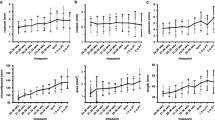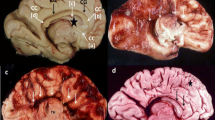The dynamics of the intrauterine development of the corpus callosum (CC) of the brain were studied in a prospective cohort trial of 100 large fetuses (birth weight 4000 g and above, group mean 4350 ± 250 g) with symmetrical and asymmetrical development in terms of the weight-to-length coefficient. The control group consisted of 50 fetuses with mean body weight 3452 ± 287 g. The length, thickness, and width of the CC were measured by multiplane ultrasound scanning. Slowing of the rate of increase in CC length was found in large fetuses from week 33 as compared with the control group. Comparative analysis of CC measures in large fetuses in relation to developmental symmetry revealed significantly smaller length from week 27. CC width in large fetuses with asymmetrical development was significantly smaller than with symmetrical development from week 21 to the end of the development period.
Similar content being viewed by others
References
D. A. Sokolov, A. D. Chertova, S. Yu. Durov, and N. A. Nasonova, “Morphological variation in the corpus callosum in humans,” Zh. Anat. Histopatol., 3, No. 2, 47–51 (2014).
O. V. Sherstneva, “Prenatal ultrasound diagnosis of adhesions of the corpus callosum,” Med. Alman., No. 4, 17, 259–261 (2014).
R. Achiron and A. Achiron, “Transvaginal assessment of the early fetal brain, “ Ultrasound Obstet. Gynecol., 1, No. 5, 336–344 (1991).
R. Achiron and A. Achiron, “Development of the human fetal corpus callosum: a high-resolution cross sectional sonographic study,” Ultrasound Obstet. Gynecol., 18, No. 4, 343–347 (2001).
Z. Chen, J. Li, J. Sun, and L. Ma, “Changes in subcortical white matter and corpus callosum volumes in patients with type II diabetes mellitus,” Acta Acad. Med. Sinicae, 35, No. 5, 503–514 (2013).
C. Egana-Ugrinovic, M. Sanz-Cortes, C. Couve-Perez, et al., “Corpus callosum differences assessed by fetal MRI in late-onset intrauterine growth restriction and its association with neurobehavior,” Prenat. Diagn., 34, 843–849 (2014).
H. Huang, J. Zhang, S. Wakana, et al., “White and gray matter development in human fetal newborn and pediatric brains,” Neuroimage, 33, No. 1, 27–38 (2006).
J. D. Loser and E. C. Alvord, “Agenesis of the corpus callosum,” Brain, 91, 553–570 (1968).
G. Malinger and H. Zakut, “The corpus callosum, normal development as shown by transvaginal sonography,” Am. J. Roentgenol., 161, No. 5, 1041–1043 (1993).
L. K. Paul, “Development malformation of the corpus callosum: a review of typical callosal development disorders with callosal involvement,” J. Neurodev. Disord., 3, No. 1, 3–27 (2011).
P. Rakic and P. I. Yakovlev, “Development of the corpus callosum and cavum septi in man,” Comp. Neurol., 132, No. 1, 45–72 (1968).
H. B. Sarnat, W. G. Bradley, R. B. Daroff, et al., “Development disorders of the nervous system,” Neurol. Clin. Pract., 2, 1258–1259 (1991).
F. A. Van Assche, “Symmetric and asymmetric fetal macrosomic in relation to long term consequences,” Am. J. Obstet. Gynecol., 177, No. 6, 1563–1564 (1997).
S. F. Witelson, “Hand and sex differences in isthmus and genu of human corpus callosum,” Brain, 112, 299–835 (1989).
Author information
Authors and Affiliations
Corresponding author
Additional information
Translated from Morfologiya, Vol. 150, No. 4, pp. 30–33, July–August, 2016.
Rights and permissions
About this article
Cite this article
Baeva, I.Y. Characteristics of the Development of the Corpus Callosum of the Brain in Large Fetuses: An Ultrasound Study. Neurosci Behav Physi 47, 627–630 (2017). https://doi.org/10.1007/s11055-017-0445-8
Received:
Revised:
Published:
Issue Date:
DOI: https://doi.org/10.1007/s11055-017-0445-8




